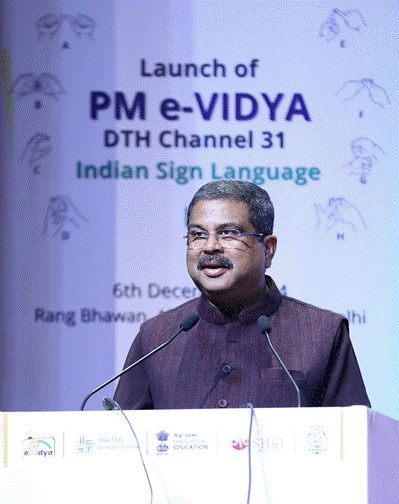Union Minister for Education Dharmendra Pradhan launched the PMeVIDYA DTH 24×7 Channel No. 31 for Indian Sign Language (ISL) today in New Delhi.
Union Minister of State for Skill Development and Entrepreneurship (Independent Charge) and Minister of State for Education, Jayant Chaudhary also graced the event. Sanjay Kumar, Secretary, Department of School Education and Literacy and Department of Higher Education; Prof. Dinesh Prasad Saklani, Director, NCERT; Smt. A Srija, Economic Adviser, DoSEL; and Dr. Sharanjeet Kaur, Chairperson, Rehabilitation Council of India (RCI) were also present at the event.
In his address, Pradhan highlighted the transformational impact of the expansion of the recognized disabilities from 7 to 21, making the legal framework more comprehensive. He noted that the National Education Policy 2020 (NEP) has prioritized the education of Children with Special Needs (CwSN), reflecting a shift towards a more inclusive education system.
Highlighting the importance of ISL, Shri Pradhan stated that sound is not the only medium for communication; alternative forms, such as sign language, play a critical role in ensuring equal opportunities for all. He called for the development of ISL to global standards and its widespread adoption, envisioning more and more individuals learning ISL to support the hearing-impaired population in India. This, he added, would help create employment opportunities as well.
Shri Pradhan also pointed to ISL’s influence in cultural expressions like dance and drama and cited examples of extraordinary individuals, to highlight the immense potential within the differently abled community. He called Channel 31 a bridge to facilitate communication and unlock this potential, making society more inclusive and progressive.
He urged stakeholders to popularize Channel 31 and ensure its reach across India, as a gateway for the world to Indian Sign Language, adding that it sets a benchmark for emerging economies. This initiative, he noted, reaffirms India’s commitment to constitutional rights, ensuring equal access to education and resources for all citizens.
Shri Pradhan concluded by emphasizing that Indian Sign Language has the potential to set global benchmarks, create large-scale job opportunities, and lead India towards a more inclusive future.
Shri Jayant Chaudhary, in his address, applauded this initiative and described it as a milestone in the country’s developmental journey toward inclusivity. He congratulated the PM eVidya Team for their commendable work. He noted that the People with Disability Act has been replaced by the Rights of Persons with Disabilities Act, reflecting the government’s focus on developing a rights-oriented framework. He emphasised the importance of identifying disabilities among school children to ensure they receive proper support, preventing any adverse impact on their learning outcomes or dropout rates. He also appreciated the effort to standardise regional languages for Indian Sign Language (ISL), with over 10,000 words standardised so far. Shri Chaudhary urged everyone to subscribe to the channels and make an effort to learn the language. He further highlighted the importance of using tools to address hearing impairment without stigma, enabling individuals with hearing disabilities to participate equally with everyone.
Shri Sanjay Kumar, in his address, commended this new and innovative initiative, highlighting how it aligns with two of the five pillars of the National Education Policy 2020—inclusiveness and accessibility. He pointed out the successful categorization of 21 types of disabilities through NCERT’s Prashast App and emphasized the importance of recognizing Indian Sign Language (ISL) as a language. He stressed the need to learn ISL to facilitate effective communication with the HI community and foster progress. He expressed his gratitude to Shri Dharmendra Pradhan for motivating the Ministry to ensure that no child is left behind and to integrate all children into the school system. Shri Sanjay Kumar also remarked on the significant work being done by regional institutes to develop ISL-based content, stating that this content would be included in the channel to make it both engaging and beneficial for the audience.
This critical initiative supports the objectives of the National Education Policy (NEP) 2020, which recommends promotion of Indian Sign Language to foster a more inclusive educational environment. Para 4.22 of NEP states that ‘Indian Sign Language (ISL) will be standardized across the country, and National and State curriculum materials developed, for use by students with hearing impairment. Local sign languages will be respected and taught as well, where possible and relevant.’
An exclusive PM e-Vidya channel devoted to the promotion of the Indian Sign Language has been conceptualised to promote ISL as a language as well as a school subject, so that the larger population has access to learning the language. This 24×7 Channel will disseminate learning content for school children (Central & State Curriculum), teachers, teacher educators and other stakeholders in the area of career guidance, skill training, mental health, class-wise curricular content, communication skills, as well as promotion of Sign Language as a language subject, just like verbal languages like Hindi, English etc., for all. The content will also be available on YouTube.
The programme witnessed participation from Hearing Impaired (HI) children, HI achievers, special educators, ISL certified interpreters and organisations working for mainstreaming the Hearing-Impaired community. The Ministers and other dignitaries also visited the exhibition stalls set up by ISLRTC, NCERT, Vidyanjali, and NIOS. The HI students rendered National Anthem in Sign Language and presented a skit as well during the event. A short film on HI achievers was also shown at the event.








